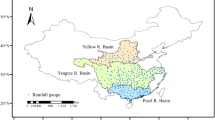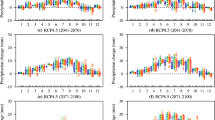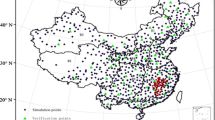Abstract
Anthropogenic-driven climate change would affect the global ecosystem and is becoming a world-wide concern. Numerous studies have been undertaken to determine the future trends of meteorological variables at different scales. Despite these studies, there remains significant uncertainty in the prediction of future climates. To examine the uncertainty arising from using different schemes to downscale the meteorological variables for the future horizons, projections from different statistical downscaling schemes were examined. These schemes included statistical downscaling method (SDSM), change factor incorporated with LARS-WG, and bias corrected disaggregation (BCD) method. Global circulation models (GCMs) based on CMIP3 (HadCM3) and CMIP5 (CanESM2) were utilized to perturb the changes in the future climate. Five study sites (i.e., Alice Springs, Edmonton, Frankfurt, Miami, and Singapore) with diverse climatic conditions were chosen for examining the spatial variability of applying various statistical downscaling schemes. The study results indicated that the regions experiencing heavy precipitation intensities were most likely to demonstrate the divergence between the predictions from various statistical downscaling methods. Also, the variance computed in projecting the weather extremes indicated the uncertainty derived from selection of downscaling tools and climate models. This study could help gain an improved understanding about the features of different downscaling approaches and the overall downscaling uncertainty.





Similar content being viewed by others
References
Arora VK, Boer GJ, Christian JR et al (2009) The effect of terrestrial photosynthesis down regulation on the twentieth-century carbon budget simulated with the CCCma earth system model. J Clim 22:6066–6088
Arora VK, Scinocca JF, Boer GJ et al (2011) Carbon emission limits required to satisfy future representative concentration pathways of greenhouse gases. Geophys Res Lett 38(5):L05805
Azpurua M, dos Ramos K (2010) A comparison of spatial interpolation methods for estimation of average electromagnetic field magnitude. Prog Electromagn Res M 14:135–145
Baigorria GA, Jones JW (2010) GiST: a stochastic model for generating spatially and temporally correlated daily rainfall data. J Clim 23:5990–6008
Belda M, Holtanová E, Halenka T, Kalvová J (2014) Climate classification revisited: from Köppen to Trewartha. Clim Res 59(1):1–13
Beniston M, Stephenson DB, Christensen OB et al (2007) Future extreme events in European climate: an exploration of regional climate model projections. Clim Chang 81:71–95
Boretti A (2013) Statistical analysis of the temperature records for the northern territory of Australia. Theor Appl Climatol 114(3–4):567–573
Boysen LR, Brovkin V, Arora VK et al (2014) Global and regional effects of land-use change on climate in 21st century simulations with interactive carbon cycle. Earth Syst Dyn 5(2):309–319
Brovkin V, Boysen LR, Arora VK et al (2013) Effect of anthropogenic land-use and land-cover changes on climate and land carbon storage in CMIP5 projections for the twenty-first century. J Clim 26(18):6859–6881
Chen J, Brissette FP (2014) Comparison of five stochastic weather generators in simulating daily precipitation and temperature for the Loess Plateau of China. Int J Climatol 34(10):3089–3105
Chen J, Zhang X, Liu W, Li Z (2008) Assessment and improvement of CLIGEN non-precipitation parameters for the Loess Plateau of China. Trans ASABE 51(3):901–913
Chen J, Brissette FP, Leconte R (2011) Uncertainty of downscaling method in quantifying the impact of climate change on hydrology. J Hydrol 401(3–4):190–202
Chen J, Brissette FP, Leconte R, Caron A (2012) A versatile weather generator for daily precipitation and temperature. Trans ASABE 55(3):895–906
Chen J, Brissette FP, Chaumont D, Braun M (2013) Performance and uncertainty evaluation of empirical downscaling methods in quantifying the climate change impacts on hydrology over two North American river basins. J Hydrol 479:200–214
Christensen NS, Wood AW, Voisin N, Lettenmaier DP, Palmer RN (2004) The effects of climate change on the hydrology and water resources of the Colorado River basin. Clim Chang 62(1–3):337–363
Christian JR, Arora VK, Boer GJ et al (2010) The global carbon cycle in the Canadian Earth system model (CanESM1): preindustrial control simulation. J Geophys Res: Biogeosci 115(G3)
Chylek P, Li J, Dubey MK, Wang M, Lesins G (2011) Observed and model simulated 20th century Arctic temperature variability: Canadian Earth System Model CanESM2. Atmos Chem Phys Discuss 11(8):22893–22907
Coulibaly P, Dibike YB, Anctil F (2005) Downscaling precipitation and temperature with temporal neural networks. J Hydrometeorol 6(4):483–496
Daccache A, Sataya W, Knox JW (2015) Climate change impacts on rain-fed and irrigated rice yield in Malawi. Int J Agric Sustain 13(2):87–103
Devak M, Dhanya CT, Gosain AK (2015) Dynamic coupling of support vector machine and K-nearest neighbour for downscaling daily rainfall. J Hydrol 525:286–301
Dewan TH (2015) Societal impacts and vulnerability to floods in Bangladesh and Nepal. Weather Clim Extrem 7:36–42
Dibike YB, Coulibaly P (2007) Validation of hydrological models for climate scenario simulation: the case of Saguenay watershed in Quebec. Hydrol Process 21(23):3123–3135
Dile YT, Berndtsson R, Setegn SG (2013) Hydrological response to climate change for Gilgel Abay River, in the Lake Tana Basin—upper Blue Nile Basin of Ethiopia. PLoS One 8(10)
Ebrahim GY, Jonoski A, Van Griensven A, Di Baldassarre G (2013) Downscaling technique uncertainty in assessing hydrological impact of climate change in the Upper Beles River Basin, Ethiopia. Hydrol Res 44(2):377–398
Environment Canada (2015) http://ec.gc.ca/cc/. Accessed 10 June 2015
Etemadi H, Samadi S, Sharifikia M (2014) Uncertainty analysis of statistical downscaling models using general circulation model over an international wetland. Clim Dyn 42(11–12):2899–2920
Fowler HJ, Blenkinsop S, Tebaldi C (2007) Linking climate change modelling to impacts studies: recent advances in downscaling techniques for hydrological modelling. Int J Climatol 27(12):1547–1578
Gagnon S, Singh B, Rousselle J, Roy L (2005) An application of the statistical DownScaling Model (SDSM) to simulate climatic data for streamflow modelling in Québec. Can Water Resour J 30(4):297–314
Gbegbelegbe S, Chung U, Shiferaw B, Msangi S, Tesfaye K (2014) Quantifying the impact of weather extremes on global food security: a spatial bio-economic approach. Weather Clim Extrem 4:96–108
Gillett NP, Arora VK, Flato GM, Scinocca JF, Von Salzen K (2012) Improved constraints on 21st-century warming derived using 160 years of temperature observations. Geophys Res Lett 39(1)
Gordon C, Cooper C, Senior CA et al (2000) The simulation of SST, sea ice extents and ocean heat transports in a version of the Hadley Centre coupled model without flux adjustments. Clim Dyn 16(2–3):147–168
Green M, Weatherhead EK (2014) A critical comparison of using a probabilistic weather generator versus a change factor approach; irrigation reservoir planning under climate change. J Water Clim Chang 5(1):13–24
Grillakis MG, Koutroulis AG, Tsanis IK (2011) Climate change impact on the hydrology of Spencer Creek watershed in Southern Ontario, Canada. J Hydrol 409(1–2):1–19
Hagemann S, Chen C, Clark DB et al (2013) Climate change impact on available water resources obtained using multiple global climate and hydrology models. Earth Syst Dyn 4(1):129–144
Harpham C, Wilby RL (2005) Multi-site downscaling of heavy daily precipitation occurrence and amounts. J Hydrol 312(1–4):235–255
Hashmi MZ, Shamseldin AY, Melville BW (2011) Comparison of SDSM and LARS-WG for simulation and downscaling of extreme precipitation events in a watershed. Stoch Env Res Risk A 25(4):475–484
Hassan Z, Shamsudin S, Harun S (2014) Application of SDSM and LARS-WG for simulating and downscaling of rainfall and temperature. Theor Appl Climatol 116(1–2):243–257
Hay LE, Clark MP, Wilby RL et al (2002) Use of regional climate model output for hydrologic simulations. J Hydrometeorol 3(5):571–590
Hempel S, Frieler K, Warszawski L, Schewe J, Piontek F (2013) A trend-preserving bias correction—the ISI-MIP approach. Earth Syst Dyn 4(2):219–236
Holman IP, Tascone D, Hess TM (2009) A comparison of stochastic and deterministic downscaling methods for modelling potential groundwater recharge under climate change in East Anglia, UK: implications for groundwater resource management. Hydrogeol J 17(7):1629–1641
Hulme M, Mitchell J, Ingram W, Lowe J, Johns T, New M, Viner D (1999) Climate change scenarios for global impact studies. Glob Environ Change 9:S3–S19
IPCC (2014) Climate Change 2014: Synthesis Report. Contribution of Working Groups I, II and III to the Fifth Assessment Report of the Intergovernmental Panel on Climate Change [Core Writing Team, Pachauri RK, Meyer LA (eds.)]. IPCC, Geneva, p 151
Joh HK, Lee JW, Park MJ et al (2011) Assessing climate change impact on hydrological components of a small forest watershed through SWAT calibration of evapotranspiration and soil moisture. Trans ASABE 54(5):1773–1781
Kazmi DH, Li J, Rasul G et al (2015) Statistical downscaling and future scenario generation of temperatures for Pakistan region. Theor Appl Climatol 120:341–350
Kilsby CG, Jones PD, Burton A et al (2007) A daily weather generator for use in climate change studies. Environ Model Softw 22(12):1705–1719
King LM, Irwin S, Sarwar R, McLeod AI, Simonovic SP (2012) The effects of climate change on extreme precipitation events in the upper Thames River Basin: a comparison of downscaling approaches. Can Water Resour J 37(3):253–274
Leander R, Buishand TA (2007) Resampling of regional climate model output for the simulation of extreme river flows. J Hydrol 332(3–4):487–496
Lenhart T, Eckhardt K, Fohrer N, Frede HG (2007) Comparison of two different approaches of senstivity analysis. Phys Chem Earth 27:645–654
Liu D, Zuo H (2012) Statistical downscaling of daily climate variables for climate change impact assessment over New South Wales, Australia. Clim Chang 115(3–4):629–666
Liu C, Hofstra N, Leemans R (2015) Preparing suitable climate scenario data to assess impacts on local food safety. Food Res Int 68:31–40
Lu Y, Qin XS, Mandapaka PV (2015) A combined weather generator and K-nearest-neighbour approach for assessing climate change impact on regional rainfall extremes. Int J Climatol 35(15):4493–4508
Mahat V, Anderson A (2013) Impacts of climate and catastrophic forest changes on streamflow and water balance in a mountainous headwater stream in southern Alberta. Hydrol Earth Syst Sci 17(12):4941–4956
Mahmood R, Babel MS (2013) Evaluation of SDSM developed by annual and monthly sub-models for downscaling temperature and precipitation in the Jhelum basin, Pakistan and India. Theor Appl Climatol 113(1–2):27–44
Mahmood R, Babel MS (2014) Future changes in extreme temperature events using the statistical downscaling model (SDSM) in the trans-boundary region of the Jhelum river basin. Weather Clim Extrem 5(1):56–66
Mahmood R, Babel MS, Jia S (2015) Assessment of temporal and spatial changes of future climate in the Jhelum river basin, Pakistan and India. Weather Clim Extrem 10:40–55
Maraun D, Wetterhall F, Ireson AM et al (2010) Precipitation downscaling under climate change: recent developments to bridge the gap between dynamical models and the end user. Rev Geophys 48(3)
McMahon TA, Peel MC, Karoly DJ (2015) Assessment of precipitation and temperature data from CMIP3 global climate models for hydrologic simulation. Hydrol Earth Syst Sci 19(1):361–377
Mearns L, Rosenzweig C, Goldberg R (1996) The effect of changes in daily and interannual climatic variability on CERES-Wheat: a sensitivity study. Clim Chang 32(3):257–292
Mehrotra R, Sharma A (2010) Development and application of a multisite rainfall stochastic downscaling framework for climate change impact assessment. Water Resour Res 46(7)
Meinshausen M, Smith SJ, Calvin K et al (2011) The RCP greenhouse gas concentrations and their extensions from 1765 to 2300. Clim Chang 109(1):213–241
Minville M, Brissette F, Leconte R (2008) Uncertainty of the impact of climate change on the hydrology of a nordic watershed. J Hydrol 358(1–2):70–83
Mullan D, Chen J, Zhang X (2015) Validation of non-stationary precipitation series for site-specific impact assessment: comparison of two statistical downscaling techniques. Clim Dyn 46(3):967–986
O'Gorman P (2012) Sensitivity of tropical precipitation extremes to climate change. Nat Geosci 5(10):697–700
Park M-J, Shin H-J, Park J-Y et al (2012) Comparison of watershed streamflow using projected MIROC3.2 HIRES GCM data and observed weather data for 2000-2009 under SWAT simulation. Trans ASABE 55(3):1003–1010
Porto de Carvalho JR, Assad ED, de Oliveira AF, Silveira Pinto H (2014) Annual maximum daily rainfall trends in the midwest, southeast and southern Brazil in the last 71 years. Weather Clim Extrem 5(1):7–15
Qian B, Gameda S, De Jong R, Falloon P, Gornall J (2010) Comparing scenarios of canadian daily climate extremes derived using a weather generator. Clim Res 41(2):131–149
Racsko P, Szeidl L, Semenov M (1991) A serial approach to local stochastic weather models. Ecol Model 57(1–2):27–41
Ribeiro Neto A, Scott CA, Lima EA, Montenegro SMG, Cirilo JA (2014) Infrastructure sufficiency in meeting water demand under climate-induced socio-hydrological transition in the urbanizing Capibaribe River basin-Brazil. Hydrol Earth Syst Sci 18(9):3449–3459
Richardson CW, Wright DA (1984) WGEN: a model for generating daily weather variables. ARS-8. U.S. Dept. of Agriculture, Agricultural Research Service, Springfield VA, Washington, D. C
Robertson AW, Ines AVM, Hansen JW (2007) Downscaling of seasonal precipitation for crop simulation. J Appl Meteorol Climatol 46(6):677–693
Saha S, Moorthi S, Pan H-L, Wu X, Wang J et al (2010) The NCEP Climate Forecast System Reanalysis. Bull Am Meteorol Soc 91(8):1015–1057
Schmidli J, Goodess CM, Frei C et al (2007) Statistical and dynamical downscaling of precipitation: an evaluation and comparison of scenarios for the European Alps. J Geophy Res: Atmos 112(4)
Scinocca JF, McFarlane NA, Lazare M, Li J, Plummer D (2008) Technical note: the CCCma third generation AGCM and its extension into the middle atmosphere. Atmos Chem Phys 8(23):7055–7074
Semenov MA, Brooks RJ (1999) Spatial interpolation of the LARS-WG stochastic weather generator in Great Britain. Clim Res 11(2):137–148
Sharma D, Babel MS (2013) Application of downscaled precipitation for hydrological climate-change impact assessment in the upper Ping River Basin of Thailand. Clim Dyn 41(9–10):2589–2602
Sharma D, Gupta AD, Babel MS (2007) Spatial disaggregation of bias-corrected GCM precipitation for improved hydrologic simulation: Ping River Basin, Thailand. Hydrol Earth Syst Sci 11(4):1373–1390
Song Y, Qiao F, Song Z, Jiang C (2013) Water vapor transport and cross-equatorial flow over the Asian-Australia monsoon region simulated by CMIP5 climate models. Adv Atmos Sci 30(3):726–738
Sunyer MA, Madsen H, Ang PH (2012) A comparison of different regional climate models and statistical downscaling methods for extreme rainfall estimation under climate change, rainfall in the urban context: forecasting, risk and climate change. Atmos Res 103:119–128
Tatsumi K, Oizumi T, Yamashiki Y (2014) Effects of climate change on daily minimum and maximum temperatures and cloudiness in the shikoku region: a statistical downscaling model approach. Theor Appl Climatol 120(1–2):87–98
Te Linde AH, Aerts JCJH, Bakker AMR, Kwadijk JCJ (2010) Simulating low-probability peak discharges for the Rhine basin using resampled climate modeling data. Water Resour Res 46(3)
Tedesco M, Fettweis X (2012) 21st century projections of surface mass balance changes for major drainage systems of the Greenland ice sheet. Environ Res Lett 7(4)
Tofiq FA, Guven A (2014) Prediction of design flood discharge by statistical downscaling and general circulation models. J Hydrol 517:1145–1153
Tryhorn L, Degaetano A (2011) A comparison of techniques for downscaling extreme precipitation over the Northeastern United States. Int J Climatol 31(13):1975–1989
van Vuuren DP, Stehfest E, den Elzen MGJ et al (2011a) RCP2.6: exploring the possibility to keep global mean temperature increase below 2°C. Clim Chang 109(1–2):95–116
van Vuuren DP, Edmonds J, Kainuma M et al (2011b) The representative concentration pathways: an overview. Clim Chang 109(1):5–31
Waltman L, Schreiber M (2013) On the calculation of percentile-based bibliometric indicators. J Am Soc Inf Sci Tech 64(2):372–379
Wang D, Hagen SC, Alizad K (2013) Climate change impact and uncertainty analysis of extreme rainfall events in the Apalachicola River basin, Florida. J Hydrol 480:125–135
Wang W, Yu Z, Zhang W, Xu J (2014) Responses of rice yield, irrigation water requirement and water use efficiency to climate change in China: historical simulation and future projections. Agri Water Manag 146:249–261
Wetterhall F, Pappenberger F, He Y et al (2012) Conditioning model output statistics of regional climate model precipitation on circulation patterns. Nonlin Processes Geophys 19(6):623–633
Wilby RL, Harris I (2006) A framework for assessing uncertainties in climate change impacts: low-flow scenarios for the River Thames, UK. Water Resour Res 42(2)
Wilby RL, Dawson CW, Barrow EM (2002) SDSM—a decision support tool for the assessment of regional climate change impacts. Environ Model Softw 17(2):147–159
Wilby R, Charles SP, Zorita E et al (2004) Guidelines for use of climate scenarios developed from statistical downscaling methods. Supporting material of the Intergovernmental Panel on Climate Change, available from the DDC of IPCC TGCIA 27
Wilby RL, Whitehead P, Wade AJ, Watts G (2006) Integrated modelling of climate change impacts on water resources and quality in a lowland catchment: River Kennet, UK. J Hydrol 330(1–2):204–220
Xu CY (1999) From GCMs to river flow: a review of downscaling methods and hydrologic modelling approaches. Prog Phy Geogr 23(2):229–249
Zamani R, Akhond-Ali A-M, Roozbahani A, Fattahi R (2016) Risk assessment of agricultural water requirement based on a multi-model ensemble framework, southwest of Iran. Theor Appl Climatol. https://doi.org/10.1007/s00704-016-1835-5
Zhou J, He D, Xie Y et al (2015) Integrated SWAT model and statistical downscaling for estimating streamflow response to climate change in the Lake Dianchi watershed, China. Stoch Env Res Risk A 29(4):1193–1210
Zorita E, von Storch H (1999) The analog method as a simple statistical downscaling technique: comparison with more complicated methods. J Clim 12(8):2474–2489 Websites Accessed
Acknowledgements
The study was supported by Academic Research Fund Tier 1 (Ref188/14; WBS no.: M4011420.030) from Ministry of Education (MOE), Singapore, and in part by Nanyang Technological University (NTU) Start-Up Grant (WBS: M4081327.030). The authors also appreciate the support from Environmental Process Modeling Centre (EPMC), Nanyang Environment & Water Research Institute (NEWRI), Singapore.
Author information
Authors and Affiliations
Corresponding author
Electronic supplementary material
ESM 1
(DOCX 1595 kb)
Rights and permissions
About this article
Cite this article
Vallam, P., Qin, X.S. Projecting future precipitation and temperature at sites with diverse climate through multiple statistical downscaling schemes. Theor Appl Climatol 134, 669–688 (2018). https://doi.org/10.1007/s00704-017-2299-y
Received:
Accepted:
Published:
Issue Date:
DOI: https://doi.org/10.1007/s00704-017-2299-y




